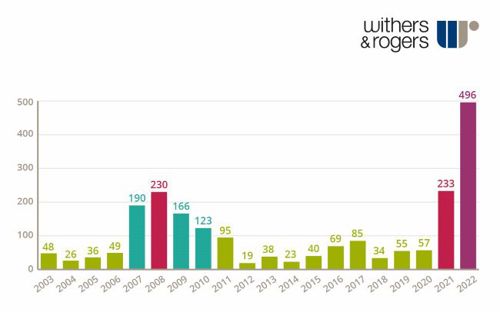The increasing realism of virtual worlds and the way we experience them is a sign of how they could evolve to become an integral part of our everyday lives. But what is driving our interest in living though an avatar and could it ever replace real world experiences?
The term ‘metaverse’ has been around since 1992 but the first metaverse is widely considered to be a video game called Second Life, which was launched in 2003, which was a 3D-generated virtual world, where human players could interact through their avatar-self in real time.
Mark Zuckerberg’s Facebook took its first big step towards the metaverse when it acquired VR hardware and platform developer, Oculus, in 2014. Since then, several other metaverse platforms have launched including Decentraland, The Sandbox and Roblox.
To map the evolution of these digital parallel worlds, Withers & Rogers has completed an analysis of global patent filings related to the ‘metaverse’ with the first wave of patent filings coming from video game developers between 2007-2010.
In 2021, a second wave of patent filings began – a sign of renewed interest in innovation activity. This appears to have been initiated by the pandemic, when take up of digital technologies surged as people spent more of their work and leisure time online. Developers focused on new areas of functionality and enhancing the user experience of virtual worlds.
The research conducted by Withers & Rogers shows that patent filings related to image processing technologies for application in the metaverse represented more than half of the total metaverse filings published in 2022, up from just 5% ten years earlier. This second surge in filings coincided with the arrival of more Asian innovators – in particular, Beijing Baidu, which had not filed any metaverse-related patent filings prior to 2022. They emerged as the second largest global filer of metaverse patent applications by mid-way through 2023.

It is also clear that innovation activity related to the metaverse is accelerating at pace. In 2022, the volume of filings for patent families recorded globally was ten times greater than in 2020, and four times greater than in 2021.
A patent application (WO2023128305) filed by Zigbang and published in 2023 demonstrates this focus on enhancing user experience within the metaverse by recreating real-world interactions. It matches user image data to a metaverse-based office environment to create a more realistic office-based group chat within the metaverse. The inventors have sought to create a graphical experience within the metaverse that enables users to recreate virtually some of the benefits of in-person meetings.
Today’s interlocking network of digital worlds provide multi-functional, social environments that users can navigate seamlessly using an array of traditional user devices, as well as virtual reality and augmented reality devices. By donning headsets, users can visit exhibitions, participate in events and enter virtual shops. They can place orders for real world goods to be delivered to their homes or purchase non-fungible tokens (NFTs) and other digital assets for use in the metaverse.
With more organisations choosing to enter the metaverse all the time, new potential uses are emerging. Some brands are carrying out early-stage experiments, with a view to selling products in the metaverse. For example, the Japanese car maker, Nissan, has recently launched a ‘demonstration experiment’ inviting consumers to test drive a car on a digital VR platform. Some universities now offer students an option to attend immersive courses in the metaverse alongside their peers.
In the future, we could also see more healthcare applications – for example, patients could be invited to attend telemedicine consultations with the best consultants regardless of where they live. Or they could attend group sessions alongside patients with the same or similar health condition where they could learn more about self-care and how to improve their quality of life.
As more opportunities to commercialise the metaverse emerge, the nature of innovation activity is shifting to focus on brand protection. For example, a patent recently issued to US-based, Roblox, is designed to help commercial entities to detect counterfeit virtual 3D objects. The technology described in the patent can search for 2D views of the same or similar objects and compare them to an authentic virtual 3D object. Once a counterfeit has been identified, the brand owner can then ask the platform concerned to remove the infringing item.
With so much focus on innovating for the metaverse, it seems likely that more businesses and individuals will choose to enter one of the virtual worlds in the next few years, if only out of curiosity. For businesses, the full extent of the commercial opportunity is yet to be realised, and for the rest of us, living in a parallel digital world could prove to be a life-enriching experience.
Author details: Phil Horler is a partner and patent attorney at European intellectual property firm, Withers & Rogers.













